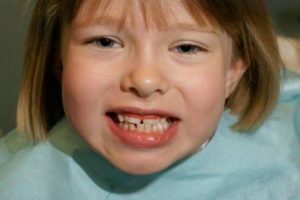 All without exception, parents want to see their children beautiful, even and healthy teeth. One of the most important factors in the proper development of the jaw system is the bite - the method of closing teeth.
All without exception, parents want to see their children beautiful, even and healthy teeth. One of the most important factors in the proper development of the jaw system is the bite - the method of closing teeth.
Unfortunately, even in early childhood, the child may have an incorrect bite, in which the teeth are closed abnormally, not corresponding to the position of the central occlusion.
Contents
- Reasons for malocclusion
- Who is at risk?
- Development options for abnormality
- Deep bite
- Distal bite
- How to determine the deviation at an early stage?
- Forming the right bite from infancy
- Correcting the tooth curves
- What can modern orthodontists do?
The causes of malocclusion
The causes of malocclusion originate in infancy:
- This may be too prolonged breastfeeding of , since at a certain age in the baby's diet there must be solid food that provides sufficient load on the chewing apparatus.
- Often an incorrect bite, and later also curved teeth, occurs in children
who are on artificial feeding ,
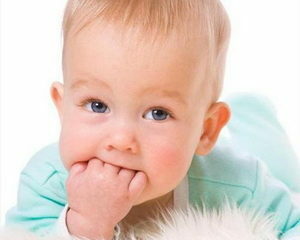 , because during breastfeeding the child performs many jaw movements, due to this the size of the lower jaw is aligned with the upper one. When feeding from a bottle, the lower jaw is not involved and lags behind in size and development.
, because during breastfeeding the child performs many jaw movements, due to this the size of the lower jaw is aligned with the upper one. When feeding from a bottle, the lower jaw is not involved and lags behind in size and development. - If the toddler often suffers from diseases of ENT organs , then it can also form an incorrect bite. Colds, nasal congestion and breathing through the mouth lead to improper growth of the facial part of the skull and development of the jaws.
- Bad playful habits of play their role in forming the occlusion. Too frequent and long use of the nipple, the habit of gnawing or sucking on various objects, fingers, etc.
The right bite can be affected by premature loss of baby teeth, or vice versa, if the molar tooth grows in the still not dairy. The violation of the timing of the growth of new teeth occurs due to a lack of calcium in the body.
If at the time of removal of the milk tooth the rootlet of the molar tooth does not yet erupt, other teeth begin to shift to the vacated place, as a result, the eruption of the molars occurs in the narrowing of the jaw and the teeth begin to "run into" each other.
According to statistics, about 90% of children suffer from malocclusion, about 10% of them need urgent consultation of the orthodontist. Unfortunately, most parents do not consider an incorrect bite to be a problem and turn to a specialist only if the violations affect the aesthetic side of the issue.
Who is at risk?
Children of several categories should be referred to the risk group:
- children in whose family someone already has a pathological bite( heredity);
- child with impaired nasal breathing( rhinitis, adenoids);
- if problems of the spine and posture are observed;
- children who suffer from chronic diseases, such as diabetes mellitus.
Options for the development of abnormality
Among the options for developing an incorrect bite, the following disorders are noted, occurring most often.
Deep bite
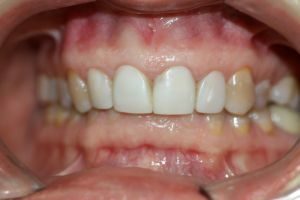 The location of the jaws, in which the upper incisors overlap the lower incisors by more than 1/3 of their height. Deep bite is fraught with serious health problems - the work of the respiratory system is disrupted, problems arise when chewing food, front teeth are overloaded and, as a result, prematurely erased.
The location of the jaws, in which the upper incisors overlap the lower incisors by more than 1/3 of their height. Deep bite is fraught with serious health problems - the work of the respiratory system is disrupted, problems arise when chewing food, front teeth are overloaded and, as a result, prematurely erased.
If the roots of the baby teeth did not resolve on time, the teeth did not fall out in time, therefore the permanent teeth have to be cut outside the dentition.
This is a common pathology, when the second tooth behind the baby teeth begins to grow. The reason for this, most likely, is the insufficient chewing load on the jaw, the lack of solid food in the diet of the child.
The solution of the problem will be an urgent consultation with the orthodontist and the removal of two milk teeth, one for which the permanent tooth is growing and symmetrical to it.
Often appearing baby teeth in a child begin to grow incorrectly. In this case, only the dentist can determine whether correction of this problem is required, because often the temporary teeth align themselves as the child grows and the jaw extends.
But sometimes the cause of the curvature of the infant teeth should be sought in infancy. If you adjust the growth of teeth by switching to the correct food is no longer possible, the doctor will appoint a special orthopedic drug.
Baby teeth fall out and there is always a chance that the curvature will go away. But what if the permanent teeth also started to grow crookedly?
The reason can be covered in childhood illnesses, poor immunity, and postural disorders. Often teeth can not erupt properly due to lack of space in the jaw.
Distal bite
Another common anomaly is the so-called distal bite, in which the upper jaw is developed much more than the lower one.
To this pathology of bite development, somatic diseases, nasopharyngeal diseases, are transferred. Uneven development of the lower jaw leads to logopedic problems and extremely rapid deterioration of the posterior teeth, so it is necessary to contact the dentist in a timely manner so that he can prescribe the treatment according to the age of the child.
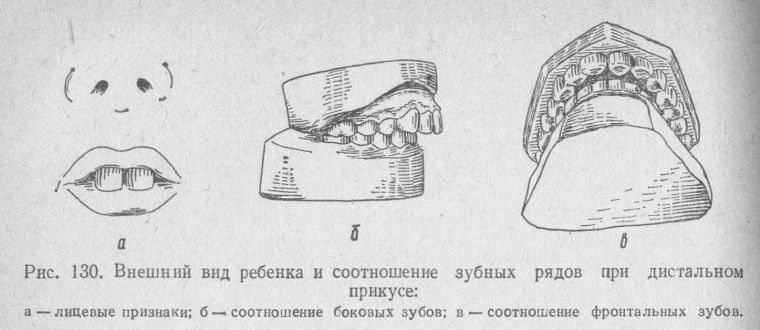
How to determine the variance at an early stage?
Caring parents closely monitor the condition of their child's teeth and begin to worry if they notice any external deviation from the norm.
It is difficult for the non-specialist to determine if there is a problem in the development of the teeth, the diagnosis can only be made by a dentist. But the parents themselves for some of the symptoms can understand that there are violations of the bite and need consultation of the orthodontist.
What you need to pay attention to: 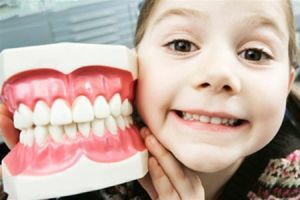
- breathes a child with his nose or more often with his mouth;
- gnaws on various items;
- how straight his posture is.
Clear signs of impairment are external signs, such as the displacement of one of the jaws forward or backward, large cracks between the teeth, too dense disposition of the teeth in relation to each other.
When a child complains of pain in the jaw and facial muscles, difficulty in eating, often traumatizing the tongue and cheeks from the inside, you should immediately visit the dentist.
The formation of the right bite from infancy
Most often parents can prevent the formation of an incorrect bite in the child from the very birth:
- As mentioned above, breastfeeding in itself causes the lower jaw to develop proportionally, but if
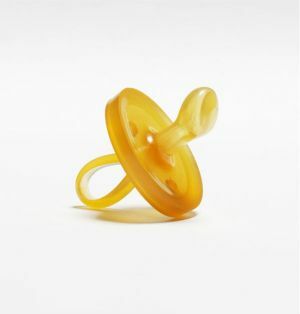 breastfeeding is ruled out, then should be used for artificial feeding with a special nipple , in which the hole is positioned so that when eating food the jaw moves, as withbreastfeeding.
breastfeeding is ruled out, then should be used for artificial feeding with a special nipple , in which the hole is positioned so that when eating food the jaw moves, as withbreastfeeding. - Keep the baby fed as if breastfeeding.
- The period of using the pacifier should be limited, it is recommended to wean the child out of it already at the 9th month of life.
- Solid food should be injected into the baby's diet according to its development of the , since the toddler should work with jaws, the chewing movements will form not only the right bite, but even teeth.
- Closely follow the habits of your child and in a timely manner disaccustom it to gnaw toys, pencils or sucking a finger, all these inconspicuous trifles seriously affect the formation of the jaws. If it is not possible to cope on its own, then it is worth turning to a neurologist who will save the baby from involuntary movements.
- When going to sleep, you need to monitor that the child sleeps in different positions of the and, of course, pay attention to the breath, whether it's mouth or nose, whether the baby snores. If breathing is difficult with the nose, you should visit the otorhinolaryngologist on time or consult a specialist who will teach the child to breathe a nose with a closed mouth, through a course of special exercises.
- During the teething, gum massage should be performed to correct the growth of the teeth, and, of course, to treat the diseased and carious teeth in time.
In normal bite, the upper jaw should protrude from the lower half a distance equal to half the crown, and the upper teeth should close with the corresponding teeth of the lower jaw.
Correction of the tooth curves
It is worth remembering that the correction of the pathological occlusion has as its goal not only the external beauty of the smile, the procedure is necessary for maintaining the health of the teeth.
Treatment objectives:
- elimination of space deficiency for tooth growth;
- correction of the location of jaws;
- alignment and movement of abnormally standing molars in the correct position;
- outer beauty of a smile.
Bite correction should be done just at the age when root teeth begin to erupt. Before, it is necessary to treat all the teeth that require it, get rid of caries and gum disease, completely sanitize the mouth.
What can modern orthodontists do?
Thanks to modern technology, orthodontists have many ways to correct bite:
- At the earliest stages, the treatment is performed using the curative gymnastics , which trains the facial muscles. Absolutely
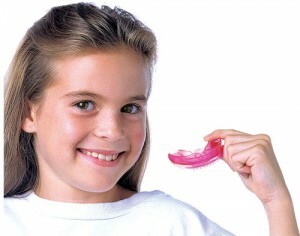 to small patients can prescribe a special vestibular plate-pacifier. But these methods are used only during the formation of temporary bite.
to small patients can prescribe a special vestibular plate-pacifier. But these methods are used only during the formation of temporary bite. - To children aged 5-10 years, an orthodontist will most likely prescribe wearing removable preorthodontic trainers or plates. The main advantage of such devices is wearing only a few hours a day and during sleep, and their effectiveness is undeniable. Trainers will save the child from harmful oral habits, for example, biting the lips, and also help the correct growth and alignment of the teeth.
- For older children, after a complete change of milk teeth, the above methods are no longer suitable and braces are used for treatment. The fixed device helps to move the teeth in the correct position and represents small locks that are attached to the teeth and are connected together by an arc. The treatment takes a long time, at the end it is recommended to wear a retina, which will help to keep the teeth in a natural position, since they are prone to displacement in principle.
- In some cases requires the extraction of permanent teeth , which most doctors are trying to avoid. Removal is a compulsory measure and it may be required if the teeth grow too closely and there is not enough space for the growth of new ones. In rare cases, surgery of the facial surgeon is performed to treat severe anomalies.
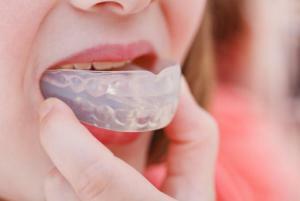 Correction of curvature of the teeth includes two directions: treatment of provoking pathologies and prevention. To prevent the appearance of an incorrect bite, it is necessary to treat sick young teeth in a timely manner, it is very important that they have their time in place.
Correction of curvature of the teeth includes two directions: treatment of provoking pathologies and prevention. To prevent the appearance of an incorrect bite, it is necessary to treat sick young teeth in a timely manner, it is very important that they have their time in place.
According to the doctor's indications, it is necessary to remove the sick teeth in time, and sometimes to remove defects it is necessary to replace the removed tooth with artificial teeth.
Of course, hygiene of the oral cavity, proper diet, prevention of any chronic diseases should be observed.
From early childhood, it is necessary to instill in the child the skills of oral care and eradicate the bad habits associated with the placement of various objects in the mouth. These simple measures will help to prevent long-term and expensive treatment. 
An incorrect bite is a problem not only associated with the oral cavity, but also affecting the functioning of many other organs.
That's why it is very important to closely monitor the development of the child and prevent the pathology of the bite, because it is much easier to fix all the deficiencies at an early age, until the musculoskeletal system is formed, since later it will be almost impossible to influence the location of the jaws.
Bite correction is not only an external beauty, but also ensuring the sound health of your child.
